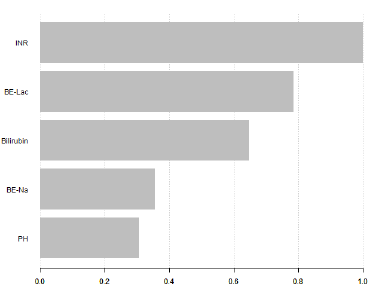Background/Aims: Metabolic acidosis is a common complication in patients with cirrhosis at the intensive care units (ICUs) and associated with increased mortality. The aim of our research was to explore the epidemiology and risk factors of metabolic acidosis in critically ill patients with cirrhosis.
Materials and Methods: A total of 975 patients with cirrhosis were selected into our study, and all participants were followed up for at least 28 days. Cox regression model and machine-learning algorithm were used to identify the importance of different risk factors, respectively. Finally, an improved prognostic model as Model for End-stage Liver Disease and metabolic acidosis (MELD-MA) was developed.
Results: Among the 975 patients with liver cirrhosis, 506 had metabolic acidosis, including 257 patients who had decompensated metabolic acidosis at ICU admission. The 28-day mortality was 41% (206/506) in patients with metabolic acidosis. Bilirubin (hazard ratio (HR): 1.023, 95% confidence interval (CI): 1.011-1.036), international normalized ratio (HR: 1.527, 95% CI: 1.332-1.750), pH (HR: 0.173, 95% CI: 0.047-0.640), BE-Lac (HR: 0.907, 95% CI: 0.868-0.948), and BE-Na (HR: 0.923, 95% CI: 0.859-0.991) were considered as independent prognostic parameters for 28-day mortality. MELD-NA had significantly higher discrimination (area under the receiver operating characteristic curve 0.79) than MELD and Child-Pugh score.
Conclusion: Critically ill patients with cirrhosis have a high mortality rate and poor prognosis because of the high prevalence of metabolic acidosis. Lactic acidosis is the worst prognosis of all types of metabolic acidosis. MELD-MA performs well on the short-term mortality assessment in critically ill patients with cirrhosis and metabolic acidosis.
Cite this article as: Gao F, Lin MT, Yang XY, et al. Metabolic acidosis in critically ill patients with cirrhosis: Epidemiology and short-term mortality risk factors. Turk J Gastroenterol 2019; 30(10): 883-91.




.png)
.png)
